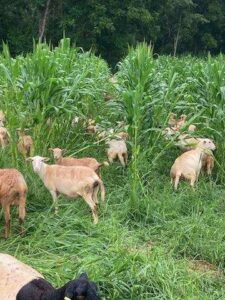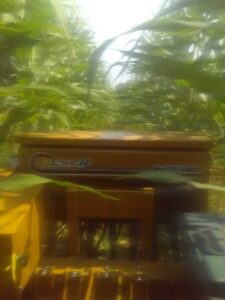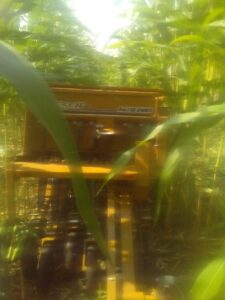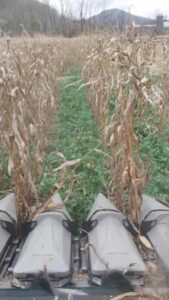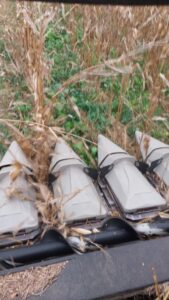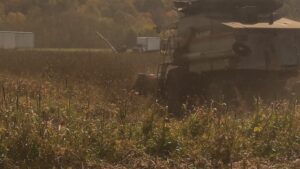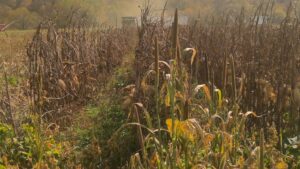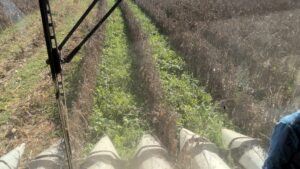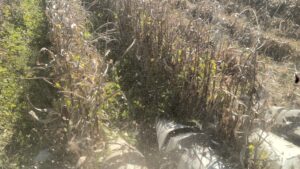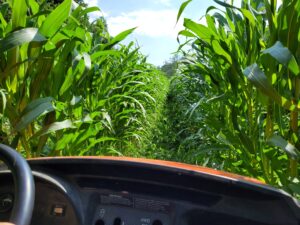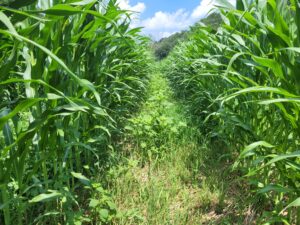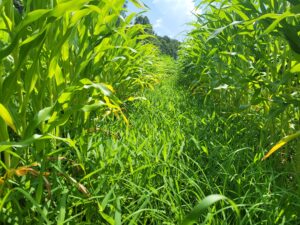Project Overview
Commodities
Practices
Proposal summary:
Green Sprig Ag presents an opportunity to pilot a two-part innovative solution to the social, economic, and environmental problems outlined above: 1) planting wide row corn and seeding cover crops on time, with proper seed to soil contact by using a narrow drill to plant between the corn rows prior to corn harvest and 2) incorporating livestock to graze the field throughout the growing season to control weeds.
This dual approach promotes a soil health principle by incorporating livestock and, by improving soil health, presents an economic case. However, as a new and innovative approach, it requires a feasibility pilot. If this approach proves effective, Green Sprig Ag is prepared to execute a large-scale project to create viable, sustainable opportunities for new farmers.
This will involve planting wide row, non-GMO corn, seeding cover crops on time with proper soil contact using a narrow drill, reducing herbicide usage by utilizing livestock to graze weeds, and diversifying income and enterprises by grazing the livestock on the cover crop.
The solution proposed in this project aims to build social and human capital, build farmer to farmer networks, and measure the soil building potential of the system. This project has been thoughtfully designed to include four proposed phases of action.
Phase I of the project was completed in 2023/2024. It involved a small proof of concept study on 4 hectares that was funded by Green Sprig Ag and VT/NRCS ICA Project. As a result, there were many lessons learned of how to implement this system successfully. The study was successful in building confidence in the concept to support moving forward to phase II of the project.
Phase II of the project is to focus on fully implementing the system to maximize success on a small scale through a pilot study from 2025-2027. The goal is to collect reputable data from a purposefully managed system. This data will provide the information needed to develop the framework for the system. Data will be collected and analyzed from the cropping system, livestock system, overall economics, soil health, and employment analytics. This data will then be used in phase III to fine tune the system. At the end of phase II, a field day will be planned to share the results and build awareness of the project. The goal is to showcase the system and build interest to identify cooperators for phase III of the project.
Phase III of the project will involve developing a framework and the structure to expand this project on a larger scale. The goal is to implement on at least 2 other farms in southwest Virginia in addition to expanding the system on Daniel’s farm. During this phase we anticipate sharing information, standard operating procedures, equipment, and other resources with cooperating farmers. This phase will help build confidence in the replicability of the system in other communities. It will also provide farmer to farmer learning and network building to provide a platform for problem solving and information sharing.
Phase IV will work with partners to look closer at the social aspects of the system and evaluate the impact of implementing this system on community viability and whole farm health. This will involve including partners from the Virginia Tech Center for Food Systems and Community Transformation and faculty from the Virginia Tech Community, Local, and Regional Food Systems Community Viability Program.
This proposal will support phase II of the overall project. Funding is needed to support (1) the increased management needed to implement this project, (2) the custom supplies needed to establish the system properly, (3) the ability to collect and analyze data, and (4) the opportunity share results of the project and showcase the system.
Addressing these problems will allow Daniel and Green Sprig Ag to explore the feasibility of expanding this system on his operation. If it proves to be net positive result, it will be expanded to additional farms in southwest Virginia with assistance from partners like Virginia Cooperative Extension, Virginia NRCS, Virginia Tech, and the Virginia Soil Health Coalition.
At that time, further information will be collected to assess the impact of implementing this system on new farms, the community surrounding those farms, and the consumer. Funding from this grant will allow Green Sprig Ag to pilot the project and is key to producing reliable results from implementing the system fully on a small scale before taking the leap to a larger scale trial or implementing on other farms.
The aim is for the project to improve the quality of life for grain producers by providing options for diversification of commodities and income. It will provide a framework to expand the farm business by incorporating value added products. This in turn will provide local sources of food products for the community. It also allows the opportunity for the community to connect to the source of their food and the people producing it. This project provides a means to protect the agrarian landscape and rural communities by allowing for preservation and expansion of thriving agricultural enterprises.
Project objectives from proposal:
As mentioned above, this project will cover Phase II of the overall project.
Phase II of the project will focus on fully implementing an intercropping system where livestock are utilized for weed management and as a way to add diversity and maximize net benefit per acre while building soil health. To do this, Daniel and his team will plant non-gmo King Fisher Corn – 67C10 Conventional on 60 inch rows. Daniel hopes to compare single row planting with twin row planting both at 28,000 seeds per acre. This comparison came from the Phase I pilot where Daniel observed that he may be able to conserve more corn yield by utilizing twin rows. Planting occurs in June after small grain harvest. Field will be fertilized according to nutrient management plan. Another challenge identified in the Phase I pilot is that the crop suffered during early growth stages with no weed control methods utilized until sheep grazed. Due to this observation Daniel plans to utilize pre-plant weed control measures.
Once the corn has almost reached tassel in July, the sheep will be let into the plot to graze the weed population in the field. Daniel learned that it is important to graze the field sooner rather than later as the sheep did much less damage when grazing earlier than they did after the ear had formed. Another key observation was that the older sheep learned how to pull the plant down and eat the ears. To avoid this issue, the plan is to graze the yearling lambs during this growth stage so that they do less damage to the corn. In the phase I pilot the sheep did a great job of managing weeds and ate almost all broadleaf weeds in the field. We plan to measure the weed pressure – in consultation with Virginia Tech weed scientist, Dr. Michael Flessner to evaluate the composition and amount of weed pressure before grazing, after grazing, and in the check plot where no grazing occurs.
In the first week of August (or immediately after grazing the weeds), black oats, cereal rye, crimson clover, purple top turnip, kale, and radish will be planted with the custom no-till drill at 100 lbs. per acre.
Corn will be harvested at the beginning of November. Yield, grain moisture, and residue will be measured. Yields in phase I were half of what they were in the typical managed check plot but there was over 9,000 lb. (2023) & 12,000 lb. (2024) of cover crop biomass at harvest. After harvest the herd of sheep grazed on the field for 3 weeks (9 acres, 280 head) in three rotations (3 acres per rotation). The cover crop will be rotationally grazed in a similar manner after harvest. Cover crop biomass and nutrient analysis will be collected prior to grazing.
During each grazing period the sheep herd will be weighed and monitored for overall animal and herd health as a result of grazing the cover crop and weeds.
The soil will be sampled and sent to Cornell Soil Health Lab for analysis at the beginning of the project period (including penetrometer readings for compaction measurement). We will also send samples to the Virginia Tech lab to analyze for a routine sample and organic matter. Samples will be sent do Dr. Franzluebbers’ lab at NC State University for analysis of soil test biological activity (STBA). Samples will be collected and sent to our faculty partner at the University of Virginia, Dr. Justin Richardson, for total analysis of phosphorus and potassium. We will also collect data on total carbon. Our partners are able to cover the cost of analysis but we are requesting funding for the labor required to collect the samples and analyze the results.
This full set of sampling measures will be collected at the end of the project period to see if the needle has moved on any measures. The plan for the full project is to sample every other year for the next 10 years as the project progresses and each field goes through a full rotation of crops (not just the corn rotation) so that the impact of the overall system, not just the corn/sheep rotation, is accounted for.
Economics are a key indicator of the success of this project and will be documented and analyzed at each stage. Part of this analysis will be collecting data and documenting the increased management required to incorporate livestock in the system. This is key to ensuring transparency with other producers when discussing the total investment of adopting this system.
This project will build upon existing funding and equipment investments from the farmer. Daniel has invested in initial infrastructure (temporary fences, permanent fencing, etc.) and purchased the custom no-till drill ($15,000). He also purchased and built the sheep herd that will be used in this project. Virginia Tech has invested funds to complete phase I of the project by providing technical guidance from Lydia Taylor and compensation for some of Daniel's time and necessary supplies. There are ongoing efforts to secure funding to pilot the innovative No-Fence system to complement this project. If we can acquire funding for this system it would allow for more intensive grazing and the opportunity to expand the pilot to more acres in the future that lack fencing infrastructure. It would also serve as an additional draw to producers to attend the outreach events planned in this project. Funding from SARE would allow Daniel to leverage the identified existing funds to produce an even more meaningful project through partnership.
